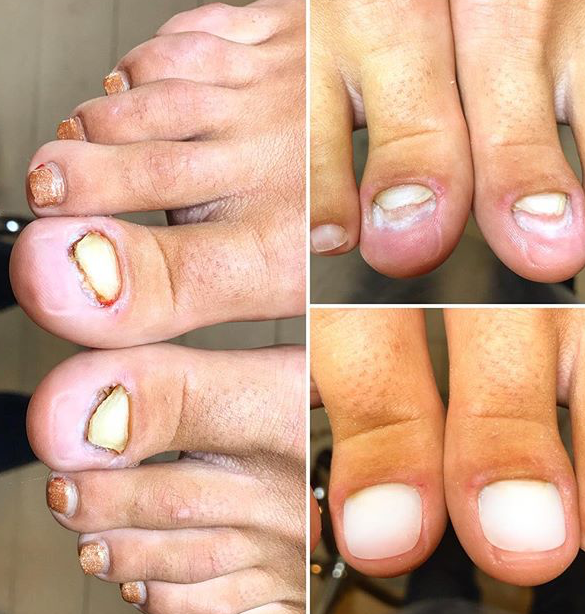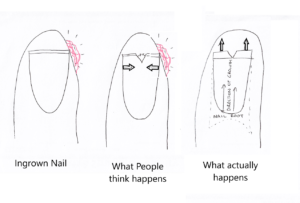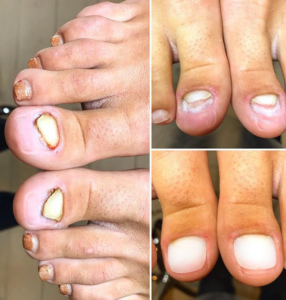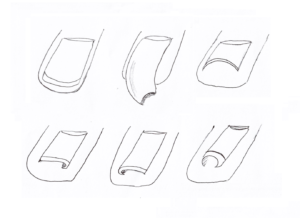
03 Jun Ingrowing Toenails
Seven Myths about Ingrowing Toenails
https://www.sportspodiatry.com.au/services/
- Cutting a “V” in the toenail will fix an ingrowing toenail, reducing the pressure and pain.
This is an old wives tale with good architectural merit but unfortunately is untrue. Nail cells are not like skin, they do not get together, they only grow in one direction from the nail root and that is towards the tip of your toe. The nail that you see is dead cells that are being pushed out. Cutting the nails like this also makes it catch on socks, hosiery, and sheets.

- An ingrown toenail will get better on its own.
By definition, an ingrown toenail has GROWN into the skin. It is like your nasty body has created its little splinter and stabbed you! The break in the skin allows bacteria to get in under the skin and fester which makes things even worse if left too long. For those who have had a splinter (or even an infected splinter), you will know what I mean, you can’t leave the thing in there, it must come out so your body can heal itself up. It is important to note if around your nail is tender, maybe because you have been wearing some sexy (uncomfortable) dress shoes for a special event, there is a chance you can catch it early before the skin is broken and everything will settle down when the torture is over. If there is an infection present (pus, clear fluid, swelling, blood, heat, all of the abovementioned) first step is to remove the splinter, then keep the area super clean so your skin can close over again and resume protecting you. This leads me to my next myth…
- Antibiotics will fix my ingrown toenail.
If there is a splinter in your hand, you would not expect a tablet to get it out. The same goes for a splinter of nails protruding into your skin. For too long I have been trying to use this as a quick fix. Don’t get me wrong, there is a place for antibiotics for treating infected ingrown toenails, but this is a last resort to settle things down and make sure you don’t get sick. But as antibiotic resistance is on the rise, and the fact antibiotics are not kind to your gut Flora, we must try and treat the nail locally before we start popping pills. The nail that is breaking the skin and causing all the pressure will still need to be trimmed so you can get better. A podiatrist has all the sterile, special instruments to do this, as well as local anesthetic if needed. If you must have a dig around yourself, PLEASE, use antiseptic. Minimise the chance of making things worse for yourself.

- If I have an ingrown toenail the whole nail has to be removed
Yes, I have heard freak stories about this too. In the past, some gung-hoe doctors would just take the whole damn thing off! Not any more people! 2 words- BODY AUTONOMY. So, if anyone even suggests it and you don’t want to, SAY NO! Taking off the whole nail is an option, definitely not the first option, and not a highly recommended option for 95% of cases that we see. It is WAY less scary than you would think though if your nail is really “un-savable”. Another option before we take the nail off is to try a prosthetic nail, especially if you are conscious of the way your nails look. We simply reduce the nail right back and have a nail technician/beautician apply a fake one! We can do this after removing the nail too. Here is an example below, and OH what a difference! No pain, no ugly, no infection. Replace when required!

- A pedicurist can treat my ingrown toenail
Now, I am NOT having a go at my friends in the beauty industry. There are pedicurists and PEDICURISTS, it is the same in all professions. But a podiatrist specialises in medical conditions of the feet. You cannot expect your beautician to deal with your pus-filled, sore toes. It is not their job! We would rather work as a team to get your nails looking just the way you want them. Stage 1- sort out the troublesome nail, clear out any infection, and heal any open wounds. Stage 2- go down the road and get your peddy, shellac, gel, varnish, and foot massage from a clean and reputable nail technician. Our hot tip- look for a beautician with Certificate 3 in Nail Technology or a CND technician.
- Keeping my toenails short will stop them from becoming ingrown.
For some people, this is the absolute answer. But not for everyone. Some people have naturally, genetically wider, or more curvy nails. Cutting the nails TOO short can encourage the nail to become ingrown, allowing the skin to flap over the edges. Our advice- cut along the line of YOUR nail, not just straight across, which can leave sharp edges that can cut into the skin and catch on everything. Leave a bit of a ‘white’ nail, so you know you are not breaking the attachment to the skin below that keeps the nasty bacteria out. Your skin is your armour!

We see lots of different shapes of nails on lots of different-shaped feet!
- Ingrown toenails develop on the big toes only
Any of the toenails can become ingrown but the big toes are the most commonly affected. If the 2nd toe is the longest toe and the footwear is too tight, it can cause the toe to hit against the front of the shoe and develop into an ingrown toenail.
Thanks for stopping by and feel free to share this info with your friends
Talk soon,
Hannah
Podiatrist at Sports and Structural Podiatry
Contact us:
202/2 Emporio Place, Maroochydore Qld 4558
Ph: (07) 54791211 | Fax: (07) 54791227
www.sportspodiatry.com.au
Email: admin@sportspodiatry.com.au

Sorry, the comment form is closed at this time.